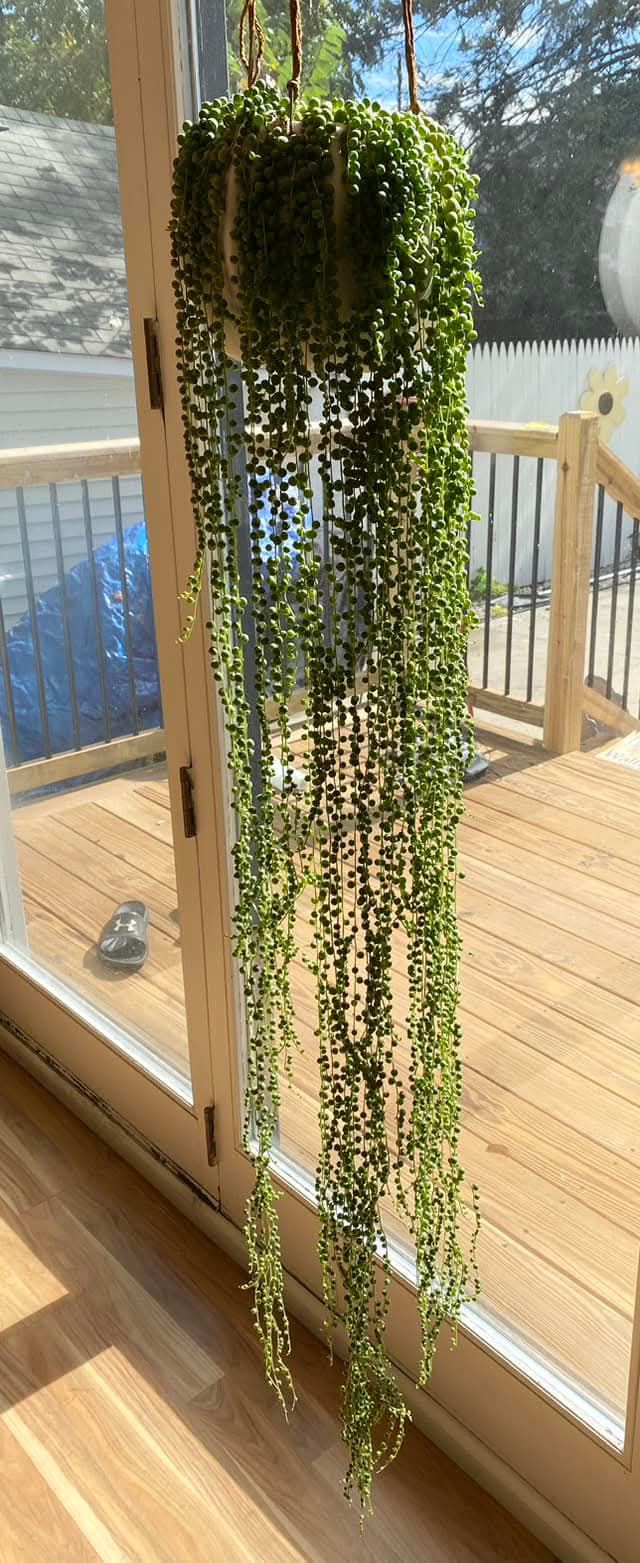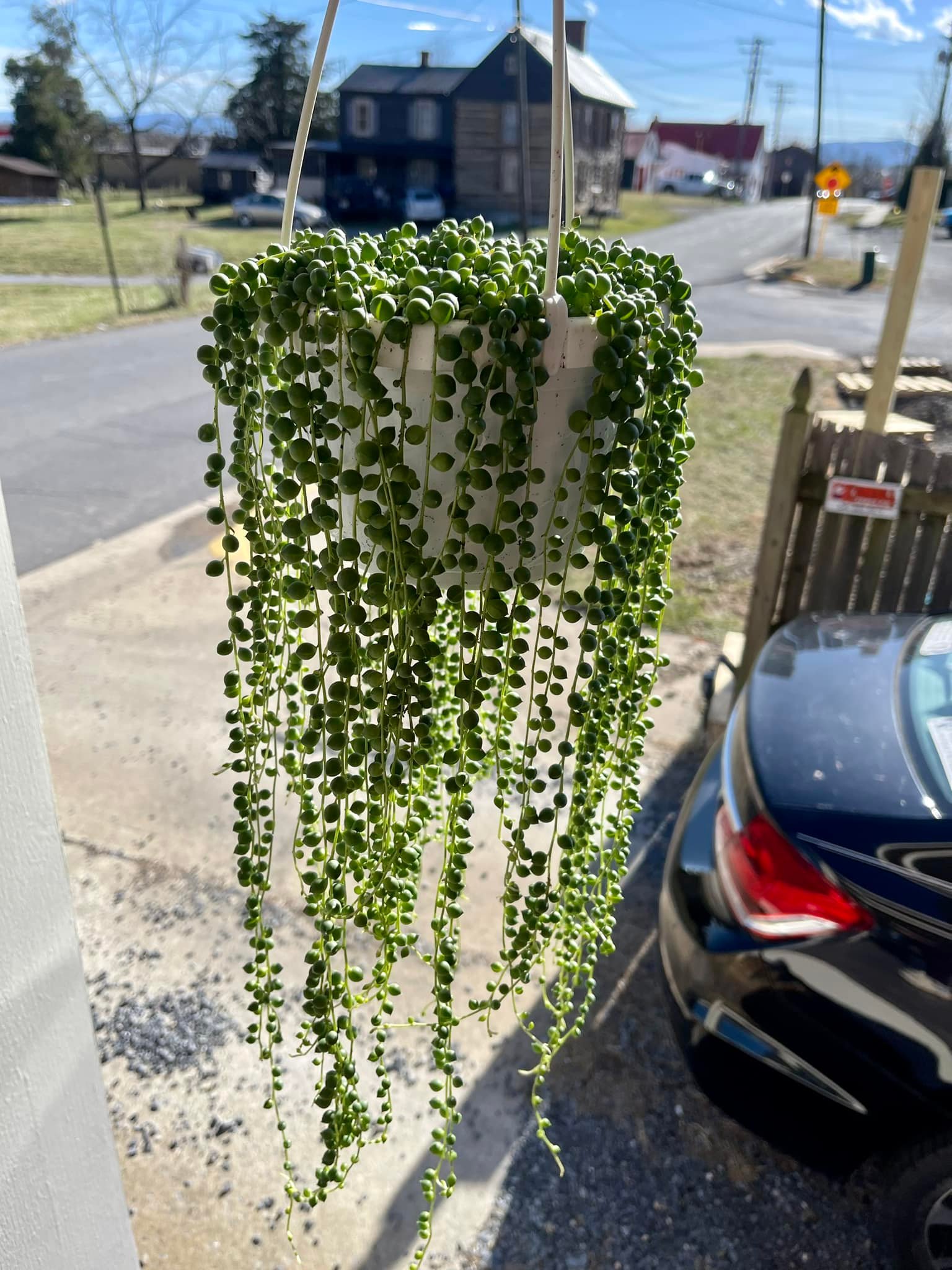
The String of Pearls (Senecio rowleyanus) is an eye-catching succulent known for its cascading vines adorned with pearl-like leaves. This elegant plant is more than just a houseplant—it’s a statement piece that adds charm to any indoor or outdoor space. But how can you ensure it thrives and continues to flourish?
In this comprehensive guide, we’ll cover everything you need to know about growing and maintaining a healthy String of Pearls. From ideal light conditions to propagation techniques and troubleshooting common issues, this guide is designed to help both beginners and experienced gardeners cultivate a stunning succulent showpiece.
I’ve provided detailed information in the article below to help with your concerns, However, if you still have questions or need more help, feel free to share photos of your plants or describe your issue on our Facebook Group. Just join the group and leave a comment on the most recent post — either I or someone from the community will respond as soon as possible. We also share helpful and unique plant care tips daily, so consider joining the group to stay updated!
Getting to Know Your String of Pearls Plant

What Makes This Succulent Unique?
The String of Pearls stands out among succulents due to its distinctive bead-like leaves, which serve a functional purpose beyond their striking appearance. These round, fleshy pearls store water, allowing the plant to survive in arid environments with infrequent rainfall. The succulent’s fast-growing, trailing vines make it an ideal choice for hanging baskets, where it can drape down elegantly, adding visual interest to any setting.
Unlike other succulents, the String of Pearls produces delicate white flowers under the right conditions. These blooms are small but emit a pleasant, cinnamon-like fragrance that can fill a room. With its low-maintenance nature and unique aesthetic, this plant has become a favorite among indoor gardeners and succulent enthusiasts alike.
Native Habitat and Growth Pattern
The String of Pearls originates from the dry, rocky landscapes of Southwest Africa, where it naturally spreads along the ground, trailing over rocks and forming dense, green mats. In its native environment, the plant relies on bright light, warm temperatures, and sandy, well-draining soil to thrive.
To replicate these conditions at home, gardeners should focus on providing bright, indirect light, well-aerated soil, and a watering schedule that mimics the infrequent rainfall of its natural habitat. By understanding its origins, you can better tailor your care routine to ensure a long and healthy life for your String of Pearls.
Essential Care Guide for a String of Pearls
1. Light Requirements
How much light does a String of Pearls need?
Light is one of the most critical factors in keeping your String of Pearls thriving.
- Prefers bright, indirect sunlight for 6-8 hours per day
- Can tolerate some direct morning sunlight, but harsh afternoon sun can cause leaf scorching
- If grown indoors, place it near a south- or east-facing window for the best light exposure
- If the plant appears leggy or elongated, it’s a sign of insufficient light; move it to a brighter spot
- During winter or in low-light conditions, consider using full-spectrum grow lights to maintain healthy growth and prevent stretching
2. Watering Needs
How often should you water a String of Pearls?
This succulent is drought-tolerant, meaning overwatering is a greater threat than underwatering.
- Water sparingly, typically every 2-3 weeks in warmer months and less frequently in winter
- Allow the soil to dry out completely between waterings to prevent root rot
- Use the soak and dry method—water thoroughly until it drains out of the pot’s bottom holes, then let it dry before watering again
- Avoid misting the leaves, as excessive moisture can lead to fungal infections and rot
- If you’re unsure when to water, gently squeeze the pearls—if they feel firm, the plant has enough moisture; if they feel soft or shriveled, it’s time to water
3. Best Soil and Pot Choice
What type of soil is ideal for a String of Pearls?
- Choose a well-draining succulent or cactus mix to prevent water retention
- Enhance aeration and drainage by adding perlite, pumice, or coarse sand to the soil mix
- Use a terracotta or unglazed ceramic pot with drainage holes to help excess moisture evaporate quickly
- Avoid using standard potting soil, as it retains too much water and can cause root issues
- If planting outdoors, ensure the soil is loose and sandy, allowing for quick drainage after rainfall
4. Temperature and Humidity Preferences
- Thrives in temperatures between 65°F to 80°F (18°C to 27°C), making it perfect for indoor environments
- Not frost-hardy—move it indoors if temperatures drop below 50°F (10°C)
- Prefers low to moderate humidity—excessive humidity can cause fungal issues and rot
- If placed in a humid area (e.g., bathroom), ensure proper ventilation to prevent moisture buildup
- Protect from cold drafts and sudden temperature fluctuations, which can stress the plant
5. Fertilizing for Healthy Growth
Should you fertilize a String of Pearls?
- Yes, but sparingly! Feed with a diluted succulent fertilizer once a month during the active growing season (spring and summer)
- Opt for a balanced, low-nitrogen fertilizer to promote steady growth without over-stretching the vines
- Avoid over-fertilization, as excessive nutrients can lead to weak, leggy growth
- No need for fertilizer in fall and winter when the plant’s growth slows down
How to Propagate a String of Pearls
Propagating in Water
- Use clean, sharp scissors to cut a healthy vine with at least 4-6 pearls
- Remove the lower 2 inches of pearls to expose the nodes
- Place the cut end in a jar of water, ensuring the nodes are submerged
- Keep the jar in bright, indirect light, changing the water every few days to prevent bacterial growth
- In 2-3 weeks, roots will appear; once established, transplant into soil and follow regular care instructions
Propagating in Soil
- Cut a healthy vine and allow the cut end to dry for a few hours to prevent rot
- Lay the vine on moist, well-draining soil, ensuring the nodes touch the soil’s surface
- Lightly press the vine down and mist the soil occasionally to maintain slight moisture
- In 3-4 weeks, roots should develop, and new growth will appear
Common Issues and How to Fix Them
1. Yellowing or Mushy Leaves
- Cause: Overwatering or poor drainage
- Solution: Allow soil to dry out completely before the next watering. Check for root rot, trim affected roots, and repot in fresh, dry soil.
2. Shriveling or Dry Pearls
- Cause: Underwatering or excessive direct sunlight
- Solution: Water thoroughly and move the plant to an area with bright, indirect light.
3. Leggy Growth
- Cause: Insufficient light exposure
- Solution: Move the plant to a sunnier location or supplement with grow lights to encourage compact, fuller growth.
